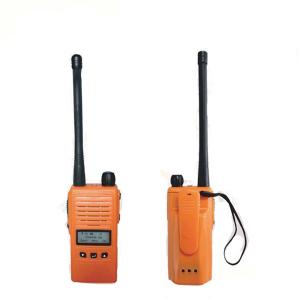156.300MHz VHF Channels Portable Two Way Marine Radio Telephone
Add to Cart
Portable Two-Way Radiotelephone For Ship Marine Vessel VHF Channels Radio Telephone
Specification
| Specifications | |
| TECHNICAL SPECIFICATION | |
| Frequency Range: | 156.300~ 162.975 MHz |
| Operating Channels: | 19 channels (default) |
| Operating Hours: | ≥8 hours (TX10%, RX10%, Standby 80%) |
| Output Power: | High 3.0W . Low 0.5W |
| BATTERY REQUIREMENTS (NBT20O) | |
| Battery Voltage: | DC 7.2V |
| Storage Temp: | ( -30'C~+70'C |
| Shelf Time: | max 1 year |
| Expiry Time: | 4 years since on board |
| DIMENSION & WEIGHT | |
| Dimension: | 256 (H) x 51.4 (W) x 46.2 (D) mm |
| Weight: | 400g (Transceiver+Emergency Battery) |
| Equipment List | |
| STANDARD | |
| Transceiver & Antenna | 1 set |
| Emergency Battery (NBT200) | 1 pc |
| Belt Clip | 1 pc |
| Wrist Rope | 1 pc |
| OPTIONS | |
| Rechargeable Battery (NBT200C) | 1 pc |
| Charger | 1 pc |
| AC/DC Adaptor | 1 pc |
JVNTW-1000 Portable Two-Way Radiotelephone
Type approval with MED, CCS and VR.
1, Designed to meet GMDSS requirements related with performance standards for survival craft two-way VHF radio telephone apparatus, such as IMO MSC.149 (77) and IEC 61097-12.
2, Compact, lightweight and rugged construction.
3, Full marine-use VHF channels can be available.
JVNXA100 Navtex Antenna
The antenna and amplifier can be used for NAVTEX receivers of most brands.
Ordinary of Marine Navigation Communication Equipment
Including magnetic compass, gyro compass, log, echo sounder, etc. It is mainly used to determine the course, speed and water depth of ships. The magnetic compass (compass) is made by using the principle that the magnetic needle points to the north and south poles of the geomagnetic field by the action of the geomagnetism.
Before the 11th century, China had used the compass for navigation, which enabled ships to determine the course and direction autonomously. This enabled the ship to change from tortuous navigation along the coastline to straight navigation, shortening the voyage and navigation time. The magnetic compass has the advantages of simplicity, reliability, and no need for power supply, but the error is large and it cannot be used near the magnetic pole. The gyro compass is to apply appropriate northing moment and damping moment on the free gyroscope to make its main axis point and track the meridian direction automatically. In 1852, French scientist L. Foucault made the first experimental gyro compass.
In 1908, the German H. Anschutz-Kempf made the first gyro compass with practical value. Later, gyro azimuth meters, gyro vertical devices, gyro azimuth levels, etc. appeared. The gyro platform compass made in 1949 can provide azimuth and horizontal reference signals with high accuracy and can be used for naval navigation and weapon control at the same time. The gyro compass basically overcomes the shortcomings of the magnetic compass, but the structure is complex and the startup time is longer. The log is used to determine the speed of the ship and record the voyage.
Starting from the invention of the towed log in 1846, the rotary log, the hydraulic log and the electromagnetic log have been invented one after another. A practical Doppler log appeared in 1967, which can automatically map the speed of a ship relative to the seabed or water layer. The echo sounder uses the principle that ultrasonic waves propagate at the same speed in the water. The ultrasonic waves are transmitted by the transmitting transducer installed on the bottom of the ship. When the ultrasonic waves are reflected by the seabed, they are received by the receiving transducer. According to the interval time and ultrasonic waves from transmission to reception The propagation speed in the water, the measured water depth is obtained. In 1922, the US Navy first used the echo sounder.



